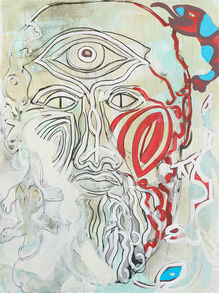
#OBA
(Ryszard Grzyb & Marcin Osiowski)
Osiowski was a contemporary of Gruppa artists, sharing their sense of humour and ideas on the role of art. Yet his unexpectedly extended stay in Antwerp only allowed him to get in touch with one of the group’s members, Ryszard Grzyb, years later. What made them paint together was their similar sense of humour and sensitivity to the absurdities of everyday life, connecting them as people and painters. Since 2002, with a higher or lower frequency, they have been making paintings jointly and signing them as OBA (BOTH).
As they suggest in the subtitle of one of their joint exhibitions: “my oba to trzecia osoba” (the both of us are a third person), the two artists really do create a new artistic quality which results from their differing styles, inspirations, and strong personalities. The artists treat the effect of their collaboration as autonomous value which crystallizes during their conversations and joint painting sessions rather than as an extension of individual pursuits. Although each of them paints differently, they are not interested in highlighting that fact. Their main objective is to extract the highest artistic quality as they both perceive it. As Osiowski summarized it, “we do something in order to get that satisfying final result rather than to elbow our way in with our own ideas.” Osiowski believes that what distinguishes his work with Grzyb from other collaborating painters is the sense of a common goal and mutual trust which they have for each other. When characterizing OBA’s works, the association with Mikhail Bakhtin’s concept of carnivalization comes to mind. Bakhtin drew attention to the “culture of laughter,” often disregarded by researchers. In Bakhtin’s view, laughter with its expression in the form of the folk carnival is ambivalent as it can express both approval and criticism. It is inherently eccentric, with some aspects of clownery or even obscenity and blasphemy. Grzyb and Osiowski’s paintings remind the viewer about the carnivalistic dimension of everyday life, in which reason and the seemingly universal acceptance of principles and order are suspended, and behaviours and social situations often considered as obvious and unquestionable are pushed out to the margin.
Osiowski and Grzyb discuss the idea of a painting together, concentrating on its formal aspects by translating words into visual language. It is even before their meeting that one of the painters has picked out a photograph, a postcard from abroad, an illustration for a book, a forgotten sketch, a thought or aphorism read recently or jotted down long ago. The division of roles is unplanned. The one who is certain and who knows what gesture should be made at a given point takes his turn painting. Their meetings are jam sessions of painting, improvisations in which a theme is interpreted and processed through turn-taking. Since its inception, Osiowski and Grzyb’s collaboration relies on their meetings as friends, and so the pleasure from working together and the joy of the very act of painting is evident in OBA’s works.







![GR OM - [kat 56], 2003, [technika], 160x120cm - [fot Adam Gut] 2000px.jpg](https://static.wixstatic.com/media/4d237b_467dd5a5906a4161b570e224f9369562~mv2.jpg/v1/fit/w_293,h_293,q_90,enc_avif,quality_auto/4d237b_467dd5a5906a4161b570e224f9369562~mv2.jpg)

![28. GR OM - [kat 22], 2002, [technika], 146x114-5cm - [fot Adam Gut] 2000px.jpg](https://static.wixstatic.com/media/4d237b_fccc364a79cf4e61844223a00eaff3cf~mv2_d_1569_2000_s_2.jpg/v1/fit/w_293,h_293,q_90,enc_avif,quality_auto/4d237b_fccc364a79cf4e61844223a00eaff3cf~mv2_d_1569_2000_s_2.jpg)
![27. GR OM - [kat 37], 2003, [technika], 160x120cm - [fot Adam Gut] 2000px.jpg](https://static.wixstatic.com/media/4d237b_d7af32be6bf04601a6aef8ea30ae5c2c~mv2_d_2000_1500_s_2.jpg/v1/fit/w_293,h_293,q_90,enc_avif,quality_auto/4d237b_d7af32be6bf04601a6aef8ea30ae5c2c~mv2_d_2000_1500_s_2.jpg)
![GR OM - [kat 06], 2002, [technika] 141x180cm - [fot Adam Gut] 2000px.jpg](https://static.wixstatic.com/media/4d237b_cd95c0e8e9414f07879ab5aa9a1efd37~mv2.jpg/v1/fit/w_294,h_293,q_90,enc_avif,quality_auto/4d237b_cd95c0e8e9414f07879ab5aa9a1efd37~mv2.jpg)
![GR OM - [kat 34], 2003, [technika], 160x120cm - [fot Adam Gut] 2000px.jpg](https://static.wixstatic.com/media/4d237b_c9df81390a2f4ab8873d57bfc92ff8f4~mv2.jpg/v1/fit/w_293,h_293,q_90,enc_avif,quality_auto/4d237b_c9df81390a2f4ab8873d57bfc92ff8f4~mv2.jpg)
![GR OM - [kat 32], 2002, [technika], 160x120cm - [fot Adam Gut] 2000px.jpg](https://static.wixstatic.com/media/4d237b_33a5c9df34494abea6db110f5c2c86d0~mv2.jpg/v1/fit/w_293,h_293,q_90,enc_avif,quality_auto/4d237b_33a5c9df34494abea6db110f5c2c86d0~mv2.jpg)
![GR OM - [kat 07], 2002, [technika], 130x11-5cm - [fot Adam Gut] 2000px.jpg](https://static.wixstatic.com/media/4d237b_6327138f981c41539487af51da5368de~mv2.jpg/v1/fit/w_294,h_293,q_90,enc_avif,quality_auto/4d237b_6327138f981c41539487af51da5368de~mv2.jpg)
![GR OM - [kat 04], 2001, [technika] 141x180cm - [fot Adam Gut] 2000px.jpg](https://static.wixstatic.com/media/4d237b_0d1485129a0a4b07b07d320c9599bfcc~mv2.jpg/v1/fit/w_293,h_293,q_90,enc_avif,quality_auto/4d237b_0d1485129a0a4b07b07d320c9599bfcc~mv2.jpg)